The Einstein Cross is a quasar located 8 billion light-years away in the constellation Pegasus. The quasar is gravitationally lensed by the galaxy ZW 2237+030, popularly known as Huchra’s Lens. In images, the quasar appears in several places in the middle of the lensing galaxy. The lensed quasar has an apparent magnitude of 16.78.
Huchra’s Lens, the foreground galaxy, lies much closer to us, at a distance of 400 million light-years. It is also known as LEDA 69457 and QSO 2237+0305 G. The galaxy has an apparent size of 0.87 by 0.34 arcminutes, while the Einstein Cross is only 1.6 by 1.6 arcseconds across.
The Einstein Cross is catalogued as Q2237+030 or QSO 2237+0305. The individual images of the quasar are designated QSO 2237+0305 A, B, C, and D.
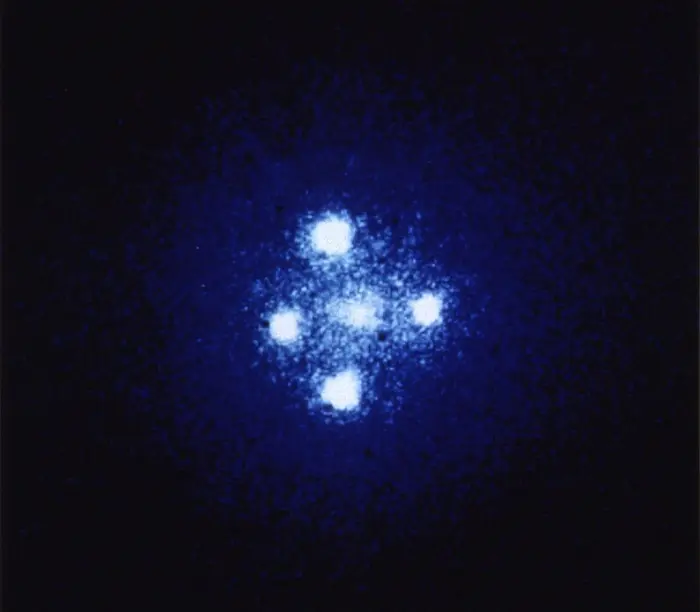
The European Space Agency’s Faint Object Camera on board NASA’s Hubble Space Telescope has provided astronomers with the most detailed image ever taken of the gravitational lens G2237 + 0305 — sometimes referred to as the Einstein Cross. The photograph shows four images of a very distant quasar which has been multiple-imaged by a relatively nearby galaxy acting as a gravitational lens. The angular separation between the upper and lower images is 1.6 arcseconds. Image credit: NASA, ESA, and STScI, 1990 (PD)
QSO 2237+0305 A and B have apparent magnitudes of 17.4, QSO 2237+0305 C has a magnitude of 18.4, and QSO 2237+0305 D shines at magnitude 18.7. The lensed components occasionally vary in relative brightness due to microlensing. This happens when a star in the lensing galaxy passes in front of one of the images of the quasar in the background.
Gravitational lensing occurs when the light of a distant object is deflected by the gravity of a massive object that lies closer, along the light path of the object in the background.
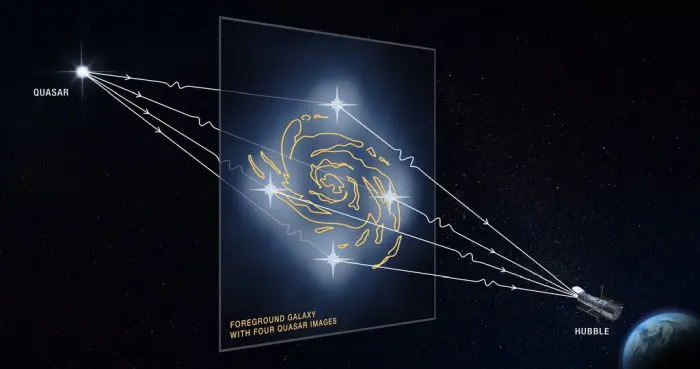
This graphic illustrates how a faraway quasar (an exceptionally bright region in the center of some distant galaxies) is altered by a massive foreground galaxy. The galaxy’s powerful gravity warps and magnifies the quasar’s light, producing four distorted images of the quasar. Dark matter is an invisible substance that makes up the bulk of the universe’s mass and creates the scaffolding upon which galaxies are built. Quadruple images of a quasar rare because the background quasar and foreground galaxy require an almost perfect alignment. Image credit: NASA, ESA and D. Player (STScI), Jet Propulsion Laboratory (JPL) (PD)
Gravitational lenses like the Einstein Cross are an excellent tool to investigate the properties of distant galaxies and they help astronomers determine the Hubble constant, which expresses the expansion rate of the universe. However, these objects are rare because they require a very close alignment of distant quasars with massive galaxies in the foreground.
Gravitationally lensed objects typically appear as Einstein rings (Chwolson rings) or arc segments when the alignment is not perfect.
The first gravitationally lensed quasar, the Twin Quasar (QSO 0957+561 A/B) in the constellation Ursa Major, was discovered using the Kitt Peak National Observatory 2.1-metre telescope in 1979.
The Einstein Cross was discovered by a team led by the American astronomer John Huchra of the Harvard-Smithsonian Center for Astrophysics in Cambridge, Massachusetts, during a survey of galaxy redshifts in 1985. Using the 1.5-m Tillinghast reflector of the Whipple Observatory, the astronomers only detected the quasar in background of the galaxy based on different redshifts, without resolving the four images of the quasar. They noted, “At 2’’ resolution, only a single optical image of the quasar is visible; its centroid is located within approximately 0’’.3 of the center of the galaxy.”
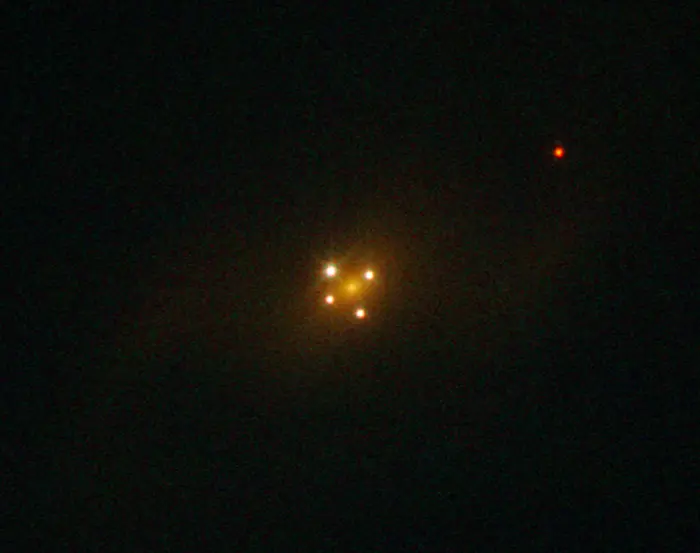
This NASA/ESA Hubble Space Telescope picture may trick you into thinking that the galaxy in it — known as UZC J224030.2+032131 — has not one but five different nuclei. In fact, the core of the galaxy is only the faint and diffuse object seen at the centre of the cross-like structure formed by the other four dots, which are images of a distant quasar located in the background of the galaxy. The picture shows a famous cosmic mirage known as the Einstein Cross, and is a direct visual confirmation of the theory of general relativity. It is one of the best examples of the phenomenon of gravitational lensing — the bending of light by gravity as predicted by Einstein in the early 20th century. In this case, the galaxy’s powerful gravity acts as a lens that bends and amplifies the light from the quasar behind it, producing four images of the distant object. This image was produced by Hubble’s Wide Field and Planetary Camera 2, and has a field of view of 26 by 26 arcseconds. Credit: ESA/Hubble & NASA (CC BY 3.0)
In the image obtained using the Faint Object Camera on the Hubble Space Telescope, four images of the distant quasar are visible in the middle of Huchra’s Lens. There is another image of the quasar in the centre, but it is too faint to see.
The gravitationally lensed quasar was named the Einstein Cross because the German-Swiss physicist Albert Einstein was the first to calculate the correct value for light bending. Einstein’s theory of general relativity predicted gravitational lensing.
However, the idea that gravity could bend light predates Einstein. It was proposed by the English physicist and mathematician Isaac Newton in 1704.
The first time that light deflection was directly observed was during the total solar eclipse on May 29, 1919. Performed by English astronomers Arthur Eddington and Frank Watson Dyson, the observations from several cities confirmed Einstein’s theory of general relativity by showing that the light from the stars that appeared to pass close to the Sun was slightly bent, and that the stars appeared very slightly out of position.
Other similar Einstein crosses have been discovered in recent decades, including the quadruple-lensed quasar HE0435-1223 in the southern constellation Eridanus and the Cloverleaf Quasar (QSO 1413+117) in Boötes.
In 2023, ESO’s Very Large Telescope detected DESI-253.2534+26.8843, a new Einstein cross consisting of a massive elliptical galaxy surrounded by four images of a distant blue galaxy. The gravitational lens system was discovered by a team of astronomers led by Aleksandar Cikota of the Gemini Observatory/NSF’s NOIRLab in the Dark Energy Spectroscopic Instrument (DESI) Legacy Imaging Surveys data.
Quasars are exceptionally luminous active galactic nuclei (AGNs) whose emissions are powered by supermassive black holes. They are the most luminous objects in the universe. A record-breaking quasar, QSO J0529-4351 in the southern constellation Pictor, was discovered using the European Southern Observatory’s Very Large Telescope (VLT) in 2024. It is the most luminous object ever observed. It has a luminosity of around 500 trillion Suns.
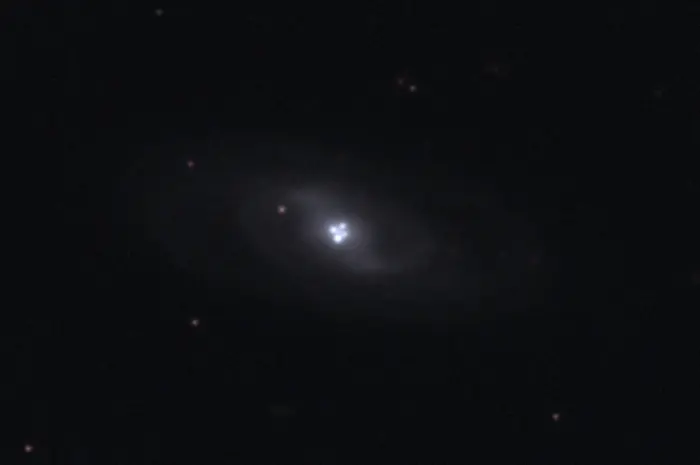
This picture of the gravitationally lensed quasar Q2237+0305 and the associated lensing spiral galaxy was taken by the 3.5-meter WIYN telescope, on the night of October 4, 1999. This system is also known as Huchra’s Lens, after its discoverer, and the Einstein Cross, because it is such an excellent example of the phenomenon of gravitational lensing, postulated by Einstein as soon as he realised that gravity would be able to bend light and thus could have lens-like effects. The four separate appearances of the same redshift 1.7 quasar are created by the redshift 0.04 galaxy whose nucleus is nicely bracketed by the quasar images. It might seem surprising that such a close alignment exists, with a galaxy exactly along the line of sight from Earth to a distant quasar, but one should remember that the Universe is large enough that unlikely things happen really quite often. This is an especially important example of a gravitational lens, because the close alignment of the galaxy nucleus and the quasar mean that the four images undergo color and brightness variations with a time scale of only a day or so. These changes can be modelled theoretically and easily monitored observationally. This is a two-color picture combining red and green images, using careful processing both to reveal the strongly blue nature of the quasar, as compared to the galaxy, and to show simultaneously the very bright quasar images and the very faint structure of the lensing galaxy. Image credit: J.Rhoads, S.Malhotra, I.Dell’Antonio (NOAO)/WIYN/NOIRLab/NSF (CC BY 4.0)
Location
The Einstein Cross lies in the constellation Pegasus, near the border with Aquarius. It appears in the region of the Water Jar, a Y-shaped asterism representing the Water Bearer‘s jar.
The Einstein Cross is a very challenging object for amateur telescopes. It may be spotted in 18-inch and larger telescopes in exceptionally good conditions. It appears as four faint patches embedded in the lensing galaxy. The galaxy LEDA 69457 shines at 15th magnitude and can be seen in medium-sized telescopes.
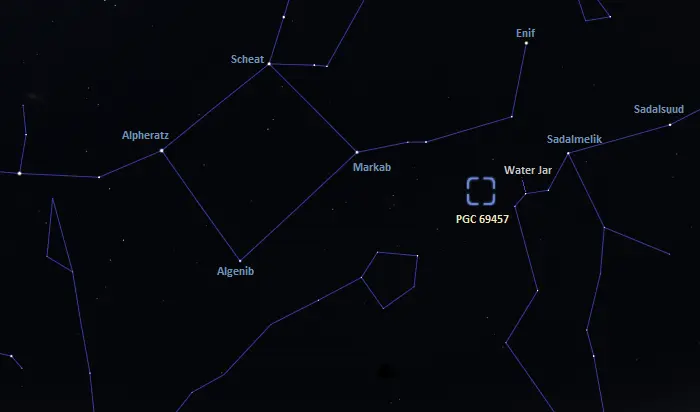
The location of the Einstein Cross and Huchra’s Lens, image: Stellarium
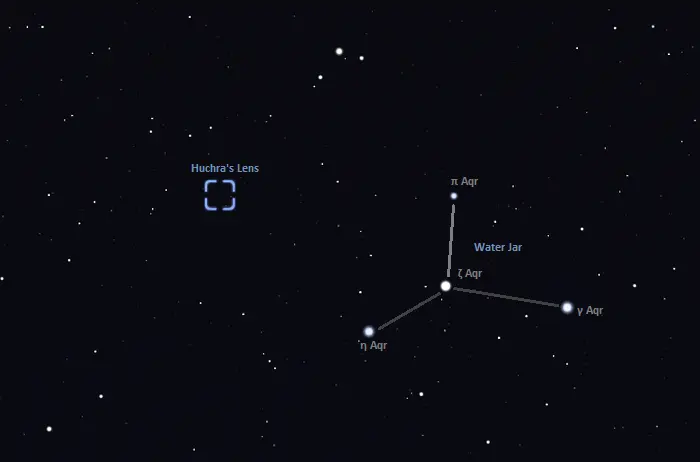
Einstein Cross and Huchra’s lens location, image: Stellarium
At declination 3° 21’, the quasar and the lensing galaxy are close enough to the celestial equator to be visible from virtually anywhere on Earth for at least part of the year.
The best time of the year to see deep sky objects in the constellation Pegasus is during the month of October, when the constellation appears higher above the horizon around 9 pm.
Einstein Cross
| Constellation | Pegasus |
| Object type | Gravitationally lensed quasar |
| Right ascension | 22h 40m 30.3s |
| Declination | +03° 21′ 31″ |
| Apparent magnitude | 16.28 |
| Apparent size | >2″ |
| Distance | 8,000,000,000 light-years (2,500,000,000 parsecs) |
| Redshift | 1.695 |
| Names and designations (quasar) | Einstein Cross, QSO J2240+0321, QSO B2237+0305, QSO B2237+030, BWSH C, KODIAQ J224030+032130, LAMOST J224030.22+032130.3 |
| Names and designations (galaxy) | Huchra’s Lens, Z 378-15, ZW 2237+030, QSO 2237+0305 G, AGC 320302, LEDA 69457, Z 2237.9+0305, NPM1G +03.0590, 2MASX J22403023+0321306, UZC J224030.2+032131 |